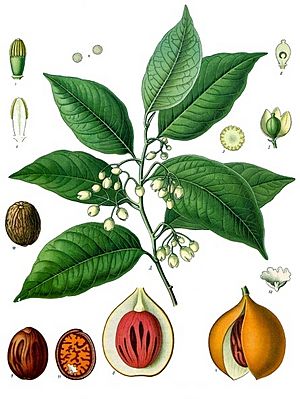Myristica facts for kids
Quick facts for kids Myristica |
|
|---|---|
 |
|
| Myristica fragrans | |
| Scientific classification |
|
| Genus: | Magnoliophyta |
| Genus: | Magnoliopsida |
| Genus: | Magnoliales |
| Family: | Myristicaceae |
| Genus: | Myristica Gronov. |
| Species | |
|
>150 |
|
Myristica is a group of plants, also known as a genus, that belongs to the Myristicaceae family. This genus includes over 150 different types of species. Most of these plants grow in warm, tropical areas. You can find them mainly in Southeast Asia, Australia, and the western Pacific islands.
The most famous species in this group is Myristica fragrans. This special tree is where we get two popular spices: nutmeg and mace.
Contents
What is Myristica?
The Myristica genus is made up of evergreen trees. This means they keep their leaves all year round. These trees are native to tropical regions. They often grow in rainforests. The trees can grow quite tall, sometimes reaching over 20 meters (about 65 feet) high.
Leaves and Flowers
Myristica trees have simple, oval-shaped leaves. These leaves are usually dark green and shiny. The flowers of Myristica plants are small. They are often pale yellow or white. These flowers usually grow in clusters. They have a sweet smell.
Fruit and Seeds
After the flowers bloom, the trees produce a fleshy fruit. This fruit looks a bit like an apricot or a small pear. When the fruit is ripe, it splits open. Inside, you find a single, hard seed. This seed is covered by a bright red, net-like covering. This covering is called an aril.
The Famous Nutmeg Tree
The most well-known Myristica species is Myristica fragrans. This tree is especially famous for its seeds. These seeds are processed to make the spice we call nutmeg. The red covering around the seed, the aril, is dried and sold as another spice called mace.
Where Nutmeg Grows
Myristica fragrans trees originally came from the Banda Islands. These islands are part of Indonesia. Today, nutmeg trees are grown in many other tropical places. These include Grenada, Malaysia, and India.
How Nutmeg and Mace are Used
Nutmeg has a warm, sweet, and slightly spicy flavor. It is often used in baking. You might find it in pies, cookies, and custards. It's also used in savory dishes. These include soups, sauces, and meat dishes. Mace has a similar but more delicate flavor than nutmeg. It is often used in lighter dishes. These include seafood and poultry. Both spices are also used in traditional medicine. They are also used to make essential oils.
History of Nutmeg
Nutmeg has a long and interesting history. For many centuries, the Banda Islands were the only place in the world where nutmeg grew. This made nutmeg a very valuable spice. It was even more valuable than gold at times. European powers, like the Netherlands and England, fought over control of the nutmeg trade. This led to many conflicts in the 17th century.
The Spice Trade
The demand for nutmeg helped drive the global spice trade. It encouraged explorers to find new sea routes. It also led to the establishment of trading posts around the world. Eventually, nutmeg trees were successfully grown outside the Banda Islands. This made the spice more widely available.
Life Cycle of the Nutmeg Tree
Nutmeg trees grow from seeds. It takes about 7 to 10 years for a nutmeg tree to start producing fruit. A mature tree can produce fruit for many decades. Some trees can even live for over 100 years.
Reproduction
Myristica fragrans trees are dioecious. This means that individual trees are either male or female. Only the female trees produce fruit. For fruit to grow, pollen from a male tree must reach a female flower. This usually happens with the help of insects or wind.
See also
 In Spanish: Myristica para niños
In Spanish: Myristica para niños

